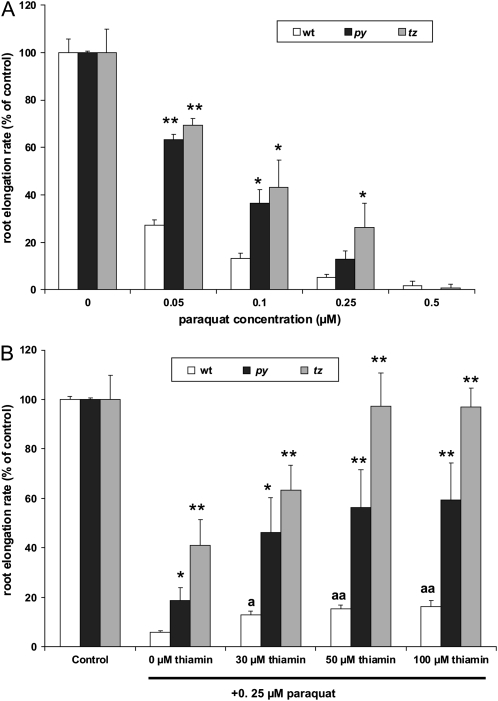Figure 9.
Responses of Arabidopsis thiamin mutants, py and tz, to oxidative stress. A, Root elongation rate of Arabidopsis wild-type, py, and tz seedlings grown on 0, 0.05, 0.1, or 0.25 μm paraquat in 100 μmol m−2 s−1 constant light. Ordinate values for wild-type (white bars), py (black bars), and tz (gray bars) plants were calculated as a percentage of the average root elongation rate of their corresponding controls, such that 100% of the wild-type, py, and tz controls (0 μm paraquat and 0 μm thiamin) equaled 8.75, 1.95, and 2.65 mm d−1, respectively. B, Root elongation rate of Arabidopsis wild-type, py, and tz seedlings grown on thiamin at the indicated concentrations in the presence or absence of 0.25 μm paraquat in 100 μmol m−2 s−1 constant light. Ordinate values for wild-type (white bars), py (black bars), and tz (gray bars) plants were calculated as a percentage of the average root elongation rate of their corresponding controls (0 μm paraquat and 0 μm thiamin), such that 100% of wild-type, py, and tz controls equaled 8.90, 1.35, and 1.40 mm d−1, respectively. All lines germinated simultaneously with a germination rate of 97% to 100%. Values represent means ± sd of three to five independent experiments. Statistically significant differences between wild-type plants grown on paraquat in the presence of thiamin and plants grown on paraquat in the absence of thiamin are shown by letters: aa, Student's t test significant at P < 0.01; a, Student's t test significant at P < 0.05. Student's t tests were also conducted to compare the root elongation rates of thiamin auxotrophs represented with dark and light gray bars with wild-type plants represented with white bars in each treatment and are shown by asterisks: **, Student's t test significant at P < 0.01; *, Student's t test significant at P < 0.05.

